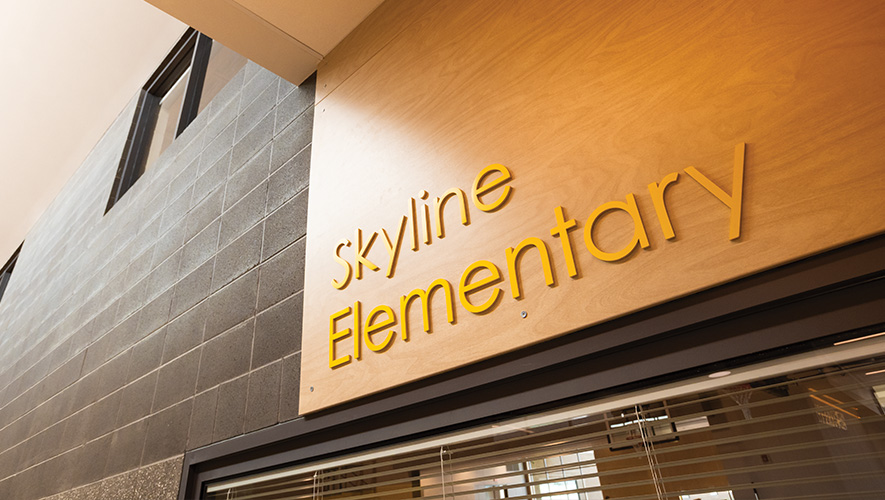Partnering with Avista to help improve schools.
As director of maintenance and operations for the Mead School District in North Spokane, Travis Bown is responsible for lighting, heating and cooling, ventilation, security and other systems that are critical to positive school environments.
For Bown and his team, that’s a big job. The Mead School District is one of the fastest-growing school districts in the state of Washington. The district serves over 10,000 students with 15 schools and five support facilities that encompass over 1.5 million square feet of building space and more than 450 acres of grounds.
According to Avista Energy Solutions Engineer Bryce Eschenbacher, Bown is “the consummate idea guy” because he continually strives to find new and better ways to improve school environments. When his ideas involve energy, he relies on Avista for feedback.
Avista Account Executive Kim Vollan adds, “He is really focused on achieving maximum energy efficiency within his budget. The proactive conversations we have had allowed him to make informed decisions about ideas he could leverage elsewhere in the district.”
Bown agrees. “Avista does a really great job of vetting a project and telling you what the simple payback will be.”
According to Bown, when he joined the Mead School District, he faced many challenges. But he brought with him his philosophy to “maintain to the highest standards.”
Says Bown: “The more efficiently buildings run, the less maintenance they require.” That philosophy aligned with the ideas of Ned Wendle, Mead School District’s Director of Facilities and capital projects lead. It’s why, when Mead passed its largest-ever facilities bond in 2015, Wendle invited Bown to participate in the board’s planning meetings.

Travis conferring with energy efficiency program manager, Rachelle Humphrey.
Eventually, the board decided to construct 50-year buildings that would require only one 30-year refresh. It would cost more upfront to build a facility, but the payback would come in operational savings.
When construction on Mead’s new Northwood Middle School began the following year, Bown had integrated nearly all the energy-efficiency best practices he had learned over the years. The new 115,000-square-foot expansion exceeded current Washington state energy codes in virtually every way, including sustainable protocols.
Bown also proudly points out that the design includes separate mechanical rooms and mezzanine spaces to house mechanical equipment for ease of access. “When a belt, fan coil or anything else needs to be changed, the maintenance staff almost never has to disturb a classroom to put up a ladder,” he says.
According to Bown, as interested parties began touring Northwood, jaws hit the floor, especially when they saw the mechanical design. “They called it a mechanical Disneyland,” he grins.
Northwood set the standard for all the district’s schools going forward.

“When Travis invited Avista to take a look at the school’s energy-efficient design, we were impressed,” says Vollan. “In fact,” she added, “the higher initial investments in energy savings prompted us to begin looking for ways to incentivize those who build higher-quality facilities.”
Currently, Avista is measuring the energy-efficiency performance of three new Mead schools—Highland Middle School (via their new Energy Use Index pilot program) and Skyline and Creekside Elementary Schools (via their new construction-site-specific measures program).
“The better these schools perform against our models, the more Avista rebates and state grants the district will be eligible to receive,” says Vollan.
According to Eshenbacher, this isn’t the first time Bown has been a big help to Avista over the years.

“He has allowed us to use his buildings as a baseline for energy use to conduct many year-long pilot studies, including a recent test for an energy-saving boiler additive,” he says.
In less than six years, Bown helped complete 203 Mead School District projects with Avista—involving everything from LED lighting and custom control systems to energy-saving block heaters for buses with the district’s transportation team.
“The upgrades have reduced my operational costs by over $210,000 annually,” said Bown, “and that is on top of receiving $392,000 in Avista rebates. As part of my strategic approach, I’ve now built lighting upgrades into my maintenance plans.”
Bown’s use of advanced HVAC and lighting control systems as well as his customization ideas has put the school district years ahead of meeting Washington State’s new clean buildings standards (House Bill 1257). Currently, over half of his buildings are in compliance. Avista is using much of this shared knowledge to help its other customers meet these new standards.
“What we gain from Travis and what he gains from us make it the perfect partnership,” said Vollan.
Watch Travis share more about these projects on Avista’s YouTube channel.